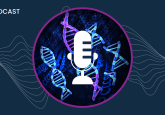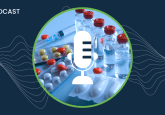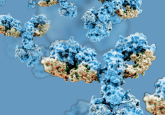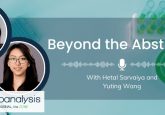The use of GenAI in bioanalysis: an interview with Priyata Kalra
During the American Association of Pharmaceutical Scientists (AAPS) PharmSci 360 2024 conference, Bioanalysis Zone caught up with industry experts across numerous disciplines to discuss their involvement with AAPS and their research. In this interview, we spoke to Priyata Kalra about the use of generative AI (GenAI) within biomedicine.
Disclaimer: The opinions expressed in this interview are those of the author and do not necessarily reflect the views of Bioanalysis Zone or Taylor & Francis Group.
Podcast transcript
[00:09] Ellen Williams: Hello and welcome to this Bioanalysis Zone podcast on the fascinating intersection of generative AI and bioanalysis. Earlier this year, I had the privilege of speaking with Priyata Kalra at the PharmSci 360 event in Salt Lake City (UT, USA). During our conversation, Priyata shared her insights on using GenAI to enhance pharmacokinetic (PK) and pharmacodynamic (PD) modeling. She also highlighted the most rewarding aspects of working in this field and offered valuable advice to those looking to venture into GenAI. This interview was recorded live from the conference floor of PharmSci 360, and we really hope you enjoy it.
[00:44] Ellen Williams: To kind of start us off, I wanted to talk a little bit about your talk that you are giving while you are here at PharmSci. It is on the use of GenAI within biomedicine. The first question I wanted to ask was around how can you describe how you have got to this point in your career so far, so what your journey’s been, and then, how you have become involved in this topic specifically. Because it is maybe not a niche topic but it is a very interesting topic. I thought maybe you could describe that.
[01:14] Priyata Kalra: It is very new in some ways but it is not that new because AI itself has been in existence since the 1950s. Going back to my journey and how I got involved, I think there is a lot of movement in my science with regards to some of the big key ethical, moral values that I hold for my own self, and I am very consistently actionable toward it from my own self. My first journey or first interaction with AI actually started very long ago during the time of my PhD where I was working on creating quantitative systems pharmacology models for biologics. And while doing so, we got in touch with understanding how to cluster things — especially for proteins — and how to inform models through those clustering algorithms in the context of PK or actually in the context of PD that informs PK. That is the first starting, you would say, dip that I got into this.
[02:24] And that helped me further to my other steps in [my] career where I actually went into working with toxicology. If you look at toxicology, toxicologists are not very much in favor of animal experiments, which means that you have to find creative, new approach methodologies, which has now become a US FDA manifesto in [the] Modernization Act. And this is something [that] in toxicology has been existing for a decade now. You are not allowed to use too many animals to do the experiments, so you have to consider using tools or technologies which can be considered like animal experiment technology to help you inform the toxicity of a particular compound.
[03:15] The passion actually arose in that direction. The passion arose like hey, why not look at everything as a technology? So even [an] animal experiment is a technology for me as much as AI is a technology for me. And the next obvious step from this is AI has been there for a long time. What we call AI currently is actually narrow AI. That means it does specific tasks by feeding into specific information and it does it to a certain degree quite well depending on how you define it. So, you have constrained it and, in those constraints, it performs as an expert.
[03:55] The next evolution obviously becomes GenAI, which is basically the LLMs (large language models). And, there was no doubt, when they came out there was no doubt that I would not use them, because as a scientist it is your curiosity that drives you to use them and also your critical thinking that drives you to see like hey is this really true that they like there was a lot of buzz around that, right? And there’s a lot of hype around it and you would like to understand, is this hype true? Which, definitely, it isn’t. And that is how I got there. Like the whole concept came from new approach methodologies and then sticking to the ends of creative technologies [that] come together. So, basically working at the boundaries of many different experimental as well as computational technologies to bring them together and try to see if you can solve a scientific problem in the context of biology to address and answer questions.
[04:49] Ellen Williams: A side question that I have. So, when you were first kind of looking at bringing AI tools into say your toxicology work, was there a point where you kind of had your, I say, your regular results, so the results that you would have put together yourself? And then did you start comparing them to the results that you were then creating using those AI tools? Were you able to kind of see, okay, they are similar, this kind of works, or were there any points where you thought, okay, these are not really matching up?
[05:24] Priyata Kalra: Usually in AI that is a normal technique, right? Like you would bring up data, you would use it as a test set and you know that test set is something that you make up and so you are pretty sure about how the connections are working in the test set. And then you, you look for a validation set and that is where you blind and you kind of try see like, okay, is this performing the way you would like it to perform?
[05:48] In this context, a lot of the things depend on the kind of data you have and how true the data is, how clean the data is. And also, on the context of asking the question only in the premise of the data. If you go outside the premise of the data, you are always going to see biases, you are going to see wrong answers. That is the case with normal AI which has been implemented or machine learning (ML) in principle. The highest form of approach of AI in today’s time in [the] medical field is ML. And you would see that all the time. So, during the time of my learning on implementing such techniques, I did see like, okay, if I conclude something here and how about if I use something like random forest, which is very basic and in today’s time considered to be very basic and considered to be the most applied or most simplistic algorithm, evolutionary algorithm that you can apply to solve a scientific problem.
[06:53] And even with that, you could see how accurate it might be on my test set and how non-accurate it might be. I think that is the exciting part of talking with a machine. Because you are able to logic and reason through how they think. Which is actually not possible for a human being. For another human being because you then have to really ask the person and it depends on so many other factors like the temperament of the person or the environment in which the person was or the day you talk to the person or the mood of it. So, in that regard, machines are a bit more trustworthy with regards to the reproducibility [of] the error. Right? Like, and so you are able to solve the issues of not being able to conclude or come to a particular accuracy by trying to understand the algorithm for example, correctly or is trying to understand the data correctly and make sure that you have some more inputs or some more parameters into it to be able to come to a good prediction. So, that is how I see it.
[08:00] Ellen Williams: Okay. So, moving a little bit more specifically toward your talk. So, how in particular are GenAI and large language models — so those LLMs that you kind of mentioned before — how are they being used to improve the drug development process? Where are you seeing–
[08:14] Priyata Kalra: –The world going?
[08:16] Ellen Wiliams: Yes. Definitely.
[08:17] Priyata Kalra: Yes. It is a very interesting question because it is a very philosophical question in today’s time with regards to drug development and this you can see already in the AAPS talks. Right at the start of our opening plenary session, you know the first question that actually got highly applauded was: what do you think about AI writing the publications, right? So, I think in today’s time, GenAI specifically is a tool that can help us be more productive. It does not equate to human intelligence. It cannot critical reason. It cannot be creative. It is creative. It has been shown to be creative because it can create nonsensical attachments and data and information, but it does not know how to critically creative think. And that is the highest quality of human knowledge creation or a human species for creating knowledge.
[09:14] So, in today’s time, the way I see drug discovery utilizing it is actually, like, pretty nascent because the first thing and the first place where we would like to really empower ourselves with using LLMs to actually advance or strengthen drug discovery in a way that the drugs come out faster. We have to make sure that we have [a] good data setup and good data sharing or open science platforms, which I think we are still in a nascent place for that kind of story.
[09:47] The second thing that I think is very important for us to have and that you can see actually a lot of scientists do. So, for example, there is something called ChemCrow that has come out, which is basically using Chem informatics. So, using ML kind of stuff to do ADME, which is absorption, distribution, metabolism and excretion information, prediction.
[10:11] But also, on top [of] wrapping up LLMs and trying to do pattern recognition and trying to compare how different an LLM would perform versus a traditional ML approach. [What] are the pitfalls of it? What are the places a person has to be careful or a chemist has to be careful about? AlphaFold in general, like, we have in this in today’s time, just few days ago, we got the Nobel Prize to AlphaFold with regards to chemistry, right? So, if you look at their protein structure folding, it is it has advanced drug discovery. There’s no doubt today you can use AlphaFold to figure out three structures of protein, which is, again, more of an AI problem than a GenAI problem because in GenAI it is LLM. But eventually I think people will start to get there because the more people will try to explore how LLMs can recognize patterns better or worse than AI or traditional ML, we will be able to come to a conclusive place where we will be able to translate this information into our daily workflows.
[11:17] But [as of] yet, I think there are few companies that are actually trying to expand this horizon. One of them is Regeneron (NY, USA), we know that. And then there is Generate [Bio]medicine (MA, USA), I have seen some of their work. Nvidia (CA, USA) has tried to go inside this domain. They have published a birth model for being able to use MICE code and have LLMs support people to do their chem informatics work. So, there are steps being taken, but I think we are very nascent and we are still at the place where we are trying to find more knowledge to inform these algorithms to be able to give us good predictions.
[12:04] Ellen Williams: So, I guess you kind of touched on a couple of examples there of where GenAI is actually enhancing some of the bioanalytical methods. So, for example, improving pharmacokinetic and pharmacodynamic modeling. So, whether you have maybe a couple more examples of where GenAI is enhancing some of those methods?
[12:30] Priyata Kalra: As I said, more than Gen AI, one more place is actually my own company. We are working… [we have] products that are able to do hybrid modeling in the context of PK and PD information. You know that PBPK models — physiologically-based pharmacokinetic models — are being used a lot in drug discovery to do model-informed drug discovery.
[12:56] Internally, in our company, we also have another software which is called ADMET Predictor, which actually takes in the SMILES code of a particular chemical or a drug and then basically uses AI to populate the PBPK model by structure information — information that can be taken out by the structure. In principle, it is already like reducing the workload of a person to try to figure out what is the log d of the compound or log p of the compound.
[13:28] Now the accuracy part, that might be a little off. You can say that, for example, for our software, we do know that we predict very good solubility. We do know we predict very good pKa. We have seen accuracy. You can look into those accuracies. But there are times when the accuracy might be a little off. That is only because that particular compound might stay outside [of] the training set information. But that is not necessarily a bad point because it is a starting point, which you can work with and optimize on for the next round. But either way, it is reducing your time to have the first hypothesis that you would like to set up for a model-informed drug discovery question. This is a very usual and very accepted pipeline, actually, within the drug discovery concept using our software that I have seen in many companies and I have supported many clients to implement it in their workflows.
[14:26] When it comes to more examples of GenAI being used, so I think one of the places where we would also slowly see a huge rise would be a lot of such platforms would allow you to have chatbots internalized, which would mean that you would end up having– you can kind of [have a] ChatGPT-like thing on a particular software and you can ask an expert information to get back information about the software. It would almost be like having the manual of the software being talked out to you, which again saves time for many people.
[15:03] But again, like here, there are hallucinations for sure. [The] user will have to double-check the information that comes out. Then the other place where I see a lot of– this is actually for experiments. There is a company which is called BenchSci (Toronto, Canada), which is actually doing AI solutions using, in some parts, LLMs to help bench scientists figure out reagents or figure out protocols that they would like to write. Some of these things can be automatized.
[15:35] And basically, a lot of these companies are trying to solve the problem of automation by using LLMs because in some way you can support someone [when] writ[ing] things. There’s also another very latest tool that has come out from somewhere in California. I think it is from San Diego. It is called Pareto. And that one basically [is] trying to help people write electronic lab reports, but using LLMs. I have not personally tried it, but I have seen a lot of great reviews about it. So, I just think that all of us need to have the curiosity to try out tools and to try to see where it fits our routine and where it does not. That is also part of my talk. That is where I want to take people on a journey for that, hey, be open-minded about it. It is not a human. It is not going to replace a human. So, why not accept it as part of our toolset and part of our Swiss knife tool kit and use it as and when required in our workflows?
[16:36] Ellen Williams: That is a very interesting perspective that actually it is not that every tool will be useful to every team or every person. It is actually let’s be curious about what is out there and we can find within those groups of tools, which ones actually work best for what we are trying to use.
[16:54] Priyata Kalra: Sometimes the most conservative tool works and it also happens to be the case in our science, right? Sometimes you can write a very complex ordinary differential equation, so I am talking [in a] language [that] I am more familiar with. So, I can write a very complex PBPK model, for example, to explain something which actually you could explain with only one equation of mathematics. Sometimes this can also happen.
[17:21] So, you have both solutions at your hand. Then it is up to you to decide which one is more important and much more reasonable to answer the kind of question you are asking for your drug. And that is going to lead to the choice of the particular toolset, right? We all do that very often in our everyday life but for some reason, we have put LLMs or GenAI on this pedestal where we are either way too biased [on] the good side of it or way too biased on the bad side of it. And I personally feel we should just have a very neutral approach toward it and explore it and try it out because only then can [we] expand the horizon of its implementation within the drug discovery pipeline.
[18:03] Ellen Williams: Thank you. That really makes sense to me. So, no, that was really nice to hear you say that. Okay. So, one of my last questions. We have kind of touched on a few specific tools but do you have maybe any in particular for those people working in the field of bioanalysis, if we are just talking about that field, and how maybe some of those tools are starting to accelerate the development of more efficient bioanalytical assays in particular?
[18:34] Priyata Kalra: Yes. So, in this regard, I think there are companies [that] are trying, so there are companies which have implemented, again, ML or deep learning techniques to help do data analysis on the bioanalytic assays that people have produced. And that is the reason why in today’s time we are able to [achieve] high throughput. Right? Like before this high throughput was not easy.
[18:58] You remember, like, I do not know if you remember when high throughput actually came out, we had these automatized robots [that] could pipette things, right? What is that? That is actually in some way AI learning what are the dimensionalities of these wells and how the pipette should work into those wells. Now let me take you to another side of the story which is not drugs but if you look into agriculture, people are using drones to fly them all around the fields. And then you can have infrared cameras on these drones and these cameras capture how a plant is diseased and then you can figure out whether the farmer should put a pesticide on it, [or] should do something else to the field, and ultimately the food that we eat is also getting affected by all of this. So, again, in this regard, we are having AI being implemented and there’s a lot of– All of this is image information, right? So, a lot of bench scientists, for example, are then able to, especially in agriculture, in the past you would need a person to go there and check the plant. Oh, is it diseased or not? And my eye versus your eye would have a very different imagination of what a disease might be for a plant. But when you automate something like this, the cameras are going to always have a certain rule and logic to identify what is diseased and therefore it is much faster, much more efficient to use something like that in the pipeline. And I think the same thing has happened for high-throughput assays. Eventually, we are also moving toward more robot-oriented assays and that is also going to change the productivity of a bioanalytical scientist.
[20:45] So, I think, the places where such tools are going to pop up more and more is going to be either in the automation of the design of the experiment itself or in the automation of helping a scientist do their analysis or in the automation of lab reporting. So currently, [those are] the places where people are exploring. And I do not have more examples of companies except again Nvidia has I think partnered with Regeneron and with many other companies to release a new platform that is going to integrate a lot of this lab writing.
[21:24] Also, I am forgetting — and I do not know why did I forget this — was if you look at Google Notebook LLMs that have been released recently, they have also an aspect of being able to write reports. So, you have many companies trying to go in this direction, trying to help people automate their workflow and I think this is amazing because this is where we will use our creative potential the most. Until now, most times, most people complain about the processes in which they are stuck. And I think some [way] or another, if we are able to utilize these tools in a very efficient way in an industrial context, the people would not feel stuck in their processes but would actually get time and energy to solve creative problems.
[22:11] Ellen Williams: That makes sense. Cool. Okay. And then my final question which I guess kind of loops back around to the beginning when we were talking about how you got into this field and how you became interested in AI tools. So, maybe could you give a piece of advice to any scientist who might want to make that jump from maybe they are a traditional bioanalyst and they actually want to change the direction of their career into a more AI-focused career. What do you think what advice would you give? And then also what has been maybe a really rewarding part of that journey for you to kind of tempt people to maybe make that move?
[22:54] Priyata Kalra: Very good question. I think a lot of this has to do with our minds. So, the first thing that we have to overcome is the fact that we are capable of everything that is out there in the world. And a lot of people start to– and even I was [at] that stage, you know, you would use the language that would bring your self-esteem down toward a point where it would be harder for you to feel like you are moving toward a transition.
[23:23] And I think that is where I feel curiosity is very important for sure, but what is also more important is consistency. And to be consistent in having this idea that, okay, if I want to transition, I will have to go through a lot of pain because it is something which is new, which means you will get out of your comfort zone, which would also mean you would fail and [you have] to be very, very comfortable with the idea of failing. And once you have failed many times, you also kind of start to recognize and learn more and more out of that. And so, you are actually not failing. You are actually gaining more information as you go on the iteration.
[24:00] And a lot of times people forget to see that, especially in the mode of transition because it is very hard to see that growth in yourself. The second thing is, always choose an ally with whom you can work in your company or in your academic career who does not stop you from exploring. Because I think, if you have a manager or if you have a professor on top of you who does not allow you to explore, obviously you will have constraints. And therefore, whatever you will be learning would not be directly translatable to your business value maybe or even to your everyday work that you are doing. And the first place where a person can learn and implement their learning is actually directly on something that is like a pet project. That is why a do-it-yourself is always very useful. I would also very much advise people to think through their transition and also to be loud and open about it, to be accountable to the world about it because the moment you speak it out to the world, the moment you are accountable to the world about it, you will walk through the line with much more rigor.
[25:15] And I think to be able to convince your manager or to be able to convince your professor is also a great skill set that people need to develop because it is a skill set of communication. And if you know how to communicate with humans, you will also learn how to communicate with [a] machine because that is another kind of communication.
[25:35] For someone who is transitioning, it is also very important to be open about different kinds of communication so that they can transition very well. These are some of my very actionable pieces of advice because that is how I learned to transition and I have been very lucky to have a manager who is been open toward accepting me. If I say, “I want to try this out on this project,” she is been very open and she is been very supportive of the fact that, “Okay, you can try it.” And that has helped me learn more and more details about this.
[26:09] I think the most rewarding part on this journey has just been to be able to empower myself alongside to be able to empower other people who are on this journey with me because I am definitely not the person who has [a] very strong AI background, but I have people in my company who have that, and I get a chance to learn through them and I get a chance to collaborate with them and they are very open-minded people.
[26:35] Each time I go into problem-solving mode with them, I actually come out more empowered because I feel that I have learned twice as much as what I would have learned if I would have just done it on my own. And I think that is where the key of finding the right people to work with you lies because that helps you grow faster. For me, it is very rewarding because I believe life is relationships. As long as you have great relationships and you build great relationships while solving a problem, I think nothing can be more satisfactory than that.
[27:09] Ellen Williams: Interesting that you have talked about that sharing of experience because I have just been to a talk right over there about diversity within teams. And actually, sometimes that can look like diversity of skillset. And you might not know the same things as somebody else or the other people in your team, but it is about that dialogue and that learning from each other that actually is the most beneficial. Having the same amount of knowledge or the same knowledge does not really give you anything. You need those differences.
[27:40] Priyata Kalra: Yes. If we would have that, we would all be second ChatGPTs, right? That is why we are human because– and that is also the thing, a lot of times I think that we also have to see [it] the opposite way. Like a lot of times, we tend to see oh I do not know this, I do not know what I would contribute here. But instead try to write a story about: I do not know this, but I think I know this. So, can I contribute X to this point? And I think when people start to think like that, you bring much better information into a problem. And also teams collaborate much better with that point of view.
[28:18] Ellen Williams: Thank you so much for speaking to me. That was fantastic. You have articulated all of your ideas so well. It was an absolute pleasure to actually be able to talk to you.
[28:27] Priyata Kalra: Pleasure also.
[28:28] Ellen Williams: No. No. Definitely mine. Thank you.
You may also be interested in:
- The fusion of microfluidics and artificial intelligence: a novel alliance for medical advancements
- FDA-approved AI-driven tool for sepsis diagnosis
- AI-supported biomarker panel identifies early-stage cancers with >99% accuracy
About the Speaker:
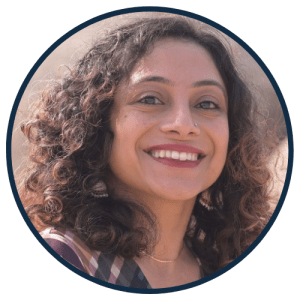 Priyata Kalra
Priyata Kalra
Senior Scientist
Simulations Plus Inc. (CA, USA)
Dr Priyata Kalra is a Senior Scientist in the Simulation Technologies R&D team for the PBPK business unit at Simulations Plus. She leads the Read-Across PBPK project for chemicals and the FDA project for building the IVIVE approach to predict the mucosal permeability of oral cavity drug products alongside supporting software development. Priyata also serves as an Expert Modeller on the European ECETOC Staged Assessment Taskforce and on the European Commission Designathon (both Brussels, Belgium). Prior to joining Simulations Plus, she worked for 3 years at Bayer and BASF (Leverkusen and Ludwigshafen, Germany) on PBPK and quantitative systems pharmacology, for both small molecules and biologics, and IVIVE approaches in drug efficacy and toxicology. She earned her PhD from the University of Heidelberg (Germany) where she worked with Bayer Pharmaceuticals, focusing on quantitative systems pharmacology models of biologics.
A passionate innovator at the intersection of machine learning, mathematics and biomedicine, Priyata aspires to bridge gaps between these disciplines. She leverages her multidisciplinary expertise to integrate ML/AI approaches with PBPK modeling as new approach methodologies for reducing animal studies. Her interests span data science, systems pharmacology, machine learning, design, crop science, blockchain and entrepreneurship.
About AAPS
American Association of Pharmaceutical Scientists (AAPS) is a non-profit association of more than 7000 scientists and professionals employed in academia, industry, regulatory and other research related to the pharmaceutical sciences worldwide. Its mission is to advance the capacity of pharmaceutical scientists to develop products and therapies that improve global health, which members pursue through four peer-reviewed journals and a variety of events in person and online.



